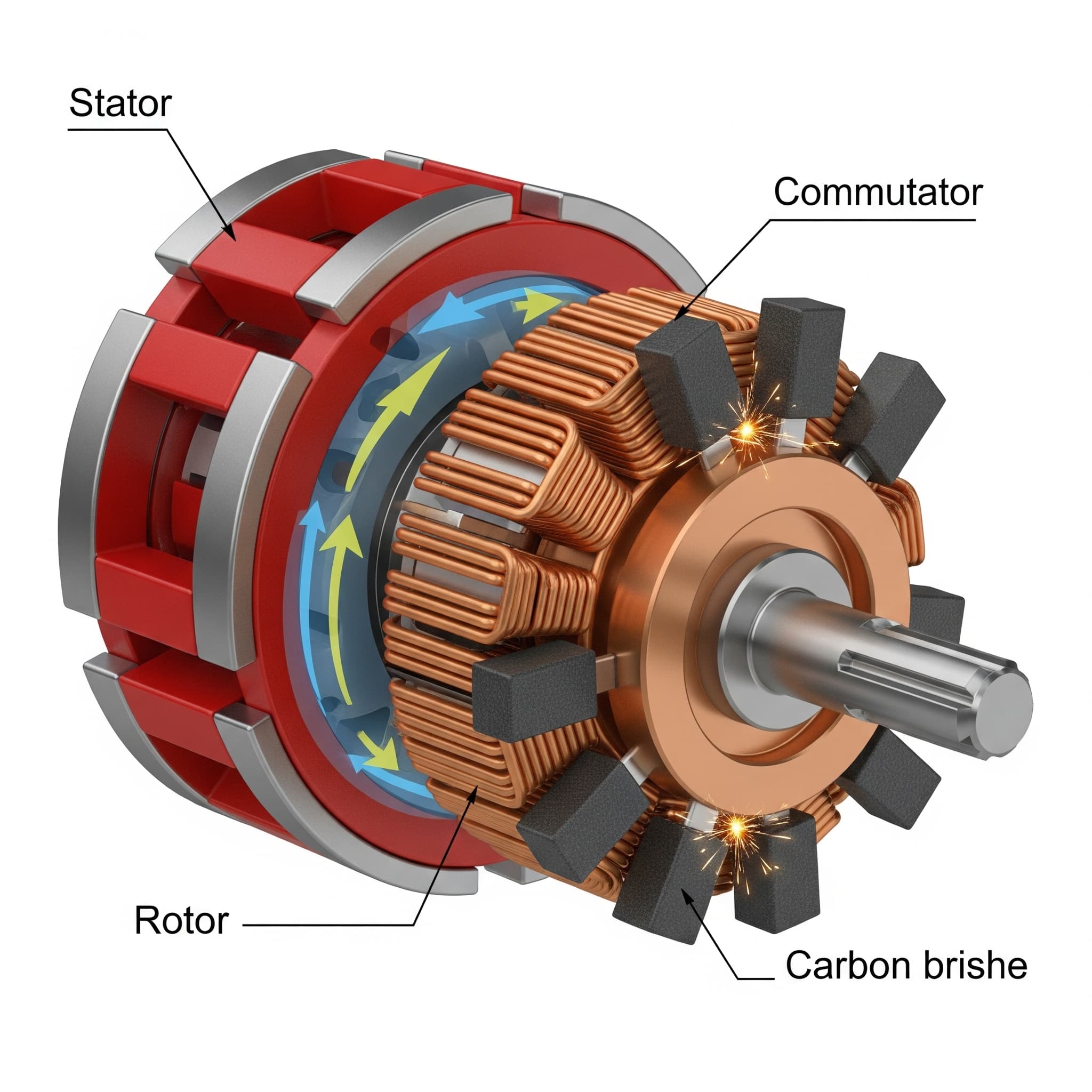DC motors are the indispensable driving force behind modern industry and daily life. Whether in electric vehicles, household appliances, or industrial automation equipment, DC motors are everywhere. This article provides an easy-to-understand yet comprehensive explanation of the fundamental principles, key components, and essential controllers of DC motors—helping you fully grasp this critical technology.
What is a DC Motor?
A DC motor is an electric machine that converts direct current (DC) electrical energy into mechanical energy. It operates based on the principle of electromagnetic induction: when current flows through coils inside the motor, it generates a magnetic field. This field interacts with permanent magnets (or another magnetic field) in the motor, creating torque that drives the rotor (the rotating part).
DC motors offer excellent speed control flexibility. By adjusting the supply voltage or magnetic field strength, the speed can be precisely controlled. This makes DC motors ideal for applications requiring accurate speed regulation. Based on their commutation method, DC motors are mainly divided into two types:
- Brushed DC Motors
- Brushless DC Motors (BLDC)
Basic Structure of a DC Motor: Key Components Explained

Despite variations in type, all DC motors share a common set of core components:
- Stator: The stationary part of the motor, responsible for generating the magnetic field. In brushed DC motors, the stator typically contains permanent magnets. In large motors, electromagnets may be used instead.
- Rotor / Armature: The rotating part of the motor and the central area for energy conversion. It usually includes a shaft, a laminated silicon steel core (to concentrate the magnetic field), and armature windings (coils) wound around the core. When current flows through the windings, torque is generated due to interaction with the stator's magnetic field.
- Commutator: A component unique to brushed DC motors. This cylindrical structure is made up of conductive segments and connected to the rotor shaft. It works in conjunction with the brushes to periodically reverse current direction in the armature windings, ensuring continuous rotation in one direction.
- Brushes:Usually made of carbon or copper, brushes are mounted on the stator. They maintain contact with the commutator, allowing current from the DC power source to reach the armature. Because of mechanical friction, brushes wear down over time and require regular maintenance.
- Bearings: Support the rotor, ensure smooth rotation, and reduce friction losses.
It’s worth noting that brushless DC motors eliminate traditional brushes and mechanical commutators. Instead, current switching is handled electronically. This results in higher efficiency, lower noise, longer lifespan, and reduced maintenance needs.
DC Motor Controllers: Precise Motor Performance Management
The DC motor controller acts as the system’s “brain,” precisely managing the motor’s performance parameters to meet various application requirements. Key functions include:
- Start and Stop: The most basic function—controlling power on/off to the motor.
- Speed Adjustment: By altering the voltage or current supplied to the motor (often using PWM—Pulse Width Modulation), the controller enables stepless speed regulation.
- Direction Control: By reversing the current in the armature windings, the controller enables forward or reverse rotation. An H-bridge circuit is commonly used for this function.
- Torque Adjustment/Limiting: The controller can limit or adjust output torque to prevent overload and ensure stable operation under specific loads.
- Protection Functions: To protect the motor and system, the controller typically includes multiple protections such as overload, overcurrent, undervoltage, and short-circuit protection.
- Precision Control and Automation Integration: Advanced DC motor controllers can integrate seamlessly with Programmable Logic Controllers (PLCs) or other automation systems to achieve high-precision control of speed, position, or tension. This makes them essential in industrial automation and robotics applications.
In short, DC motor controllers give motors intelligence and flexibility, enabling them to perform complex tasks with precision and significantly expanding their range of applications.
Recommended: CYEI DC Motors
If you're looking for high-quality, high-performance DC motor products, CYEI (Chang Yi Electric Industry) offers a wide range of DC motor solutions suitable for various industries. Whether for custom applications or standard products, CYEI provides professional technical support and services.
Learn more at the official CYEI website: CYEI DC Motors







